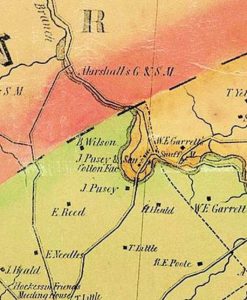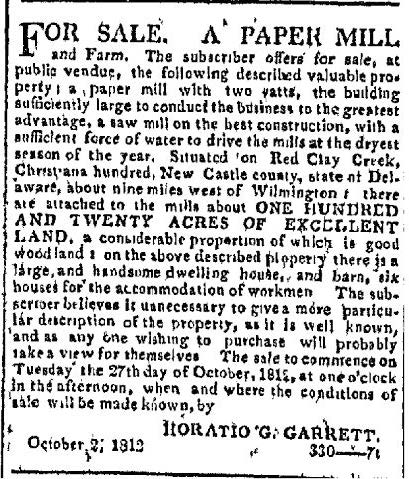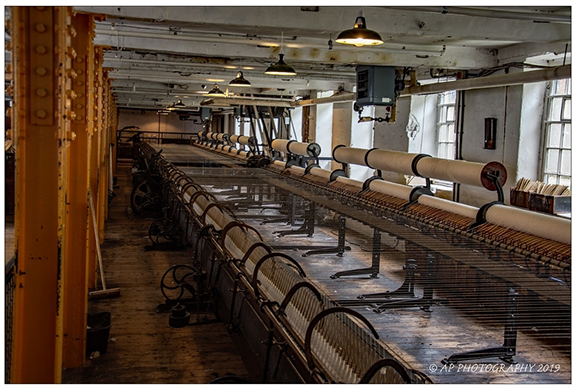PUZZLING
 Folks visiting Auburn Valley State Park learn of the Garrett family, which first settled in the area in 1726, followed by the Marshall family 33 years later. Descendants of both families established water-powered grist and saw mills along the Red Clay Creek, which served as a stepping stone to becoming significant enterprises manufacturing snuff and paper. There is one other Delaware family, the Pusey family, that got their start on the same 2-mile stretch of the Red Clay. The Puseys later became Delaware’s largest manufacturers of cotton fabric products in the mid-1800s in Wilmington.
Folks visiting Auburn Valley State Park learn of the Garrett family, which first settled in the area in 1726, followed by the Marshall family 33 years later. Descendants of both families established water-powered grist and saw mills along the Red Clay Creek, which served as a stepping stone to becoming significant enterprises manufacturing snuff and paper. There is one other Delaware family, the Pusey family, that got their start on the same 2-mile stretch of the Red Clay. The Puseys later became Delaware’s largest manufacturers of cotton fabric products in the mid-1800s in Wilmington.
The Auburn/Yorklyn Puseys, related to the Pusey family that founded Pusey & Jones in Wilmington, were awarded multiple patents for improvements to spinning machines and for ice-making equipment. It is a patent of Joseph Pusey, a descendent of Jacob Pusey who owned Auburn Mill, that stands out as unique in that the patent is not for a machine or has anything to do with machinery or the textile industry or anything typical of what the various Pusey companies were involved in. The greater Pusey family business interests in Wilmington included textiles, ship building, railroad equipment, papermaking equipment of which some is in Auburn Factory, and industrial machinery. The non-business nature of this patent is way off the beaten trail of typical Pusey patents. What was Joseph’s patent for? As a hint, it is something designed for children; however, many adults might find it of interest.
Answer
 In the early 1730s, settler John Garrett constructed a grist mill that resides today as the core of Marshall Brothers Paper Mill as perhaps some of the interior basement walls. Garrett eventually moved downstream on the Red Clay Creek a half mile to construct a snuff mill leaving the grist mill to his son Horatio Gates Garrett to operate as a paper mill. Horatio, for reasons lost in the cobwebs of time, was unsuccessful, perhaps because he couldn’t compete with the economies of scale present in Wilmington’s papermaking industry. On February 16, 1813 the original Garrett homestead and mill was sold at Sheriff’s Sale for $14,450 to Thomas Lea, a prosperous flour miller on Brandywine Creek. Lea’s nephew, Jacob Pusey, had an interest in the cotton trade and convinced his uncle to let him use the Garrett mill for making cotton fabrics for hosiery use. Lea referred to the former Garrett mill as Auburn Mill a name which is believed to have given rise to the area being called Auburn.
In the early 1730s, settler John Garrett constructed a grist mill that resides today as the core of Marshall Brothers Paper Mill as perhaps some of the interior basement walls. Garrett eventually moved downstream on the Red Clay Creek a half mile to construct a snuff mill leaving the grist mill to his son Horatio Gates Garrett to operate as a paper mill. Horatio, for reasons lost in the cobwebs of time, was unsuccessful, perhaps because he couldn’t compete with the economies of scale present in Wilmington’s papermaking industry. On February 16, 1813 the original Garrett homestead and mill was sold at Sheriff’s Sale for $14,450 to Thomas Lea, a prosperous flour miller on Brandywine Creek. Lea’s nephew, Jacob Pusey, had an interest in the cotton trade and convinced his uncle to let him use the Garrett mill for making cotton fabrics for hosiery use. Lea referred to the former Garrett mill as Auburn Mill a name which is believed to have given rise to the area being called Auburn.
Jacob outfitted Auburn Mill by early 1814 with 1,224 spindles and other supporting textile machinery. He soon employed 43 workers. The mill employed 6 men, earning $6 per week (an 1830s work week being 6 working days of 11 hours/day); 12 women, earning $2 per week; and 25 children, earning $1.25 per week. After Lea dies around 1824, his widow sells some of Lea’s mills to reduce debt including the former Garrett mill and its 114-acres to Jacob Pusey for $10,500. By the early 1830s, Pusey’s Mill at Auburn as it is now known, is processing 70,000 and 100,000 lbs. of cotton into fabric per year primarily used for hosiery. Below is a modern photo of a similar English textile factory resembling what the inside of Pusey’s cotton mill at Auburn may have looked like.
 In later years, Jacob’s sons Joseph Mendenhall Pusey and Edward Pusey, who were born in the Horatio Garrett home off what was then called Old Public Road (now Benge Road), took responsibility for daily operation of Pusey’s Mill at Auburn. With business booming, Jacob and son Joseph M. established a cotton wadding and cotton rope manufactory at Front and Tatnall Streets leaving brothers Lea and Edward to operate Pusey’s Mill on the Red Clay. Needing additional manufacturing space, the Pusey family purchased land at 13th and Poplar (now Clifford Brown Walk) Streets in Wilmington in 1860 where they construct a new cotton milling and manufacturing plant.
In later years, Jacob’s sons Joseph Mendenhall Pusey and Edward Pusey, who were born in the Horatio Garrett home off what was then called Old Public Road (now Benge Road), took responsibility for daily operation of Pusey’s Mill at Auburn. With business booming, Jacob and son Joseph M. established a cotton wadding and cotton rope manufactory at Front and Tatnall Streets leaving brothers Lea and Edward to operate Pusey’s Mill on the Red Clay. Needing additional manufacturing space, the Pusey family purchased land at 13th and Poplar (now Clifford Brown Walk) Streets in Wilmington in 1860 where they construct a new cotton milling and manufacturing plant.
In 1868 the Pusey’s Delaware Cotton Mill, alternately called Wilmington Cotton Mill, a modern steam-powered, state-of-the-art textile mill along the Brandywine Creek, outproduced Auburn’s Pusey’s Mill resulting in the water powered Red Clay mill being offered for sale. Purchased by William & James Clark, they repurposed the mill for wool instead of cotton still running on water power. The Clark brothers were familiar with the woolen trade as sons of Henry Clark who operated a woolen mill on Hyde Run near Greenbank.
 After a fire in 1869 destroys Auburn Factory as the Clark’s named it, the mill was left vacant until 1880 when it was rebuilt by the Clarks. In 1886 William bought out James’ interest. Another fire in 1888 destroyed Auburn Factory. Auburn Factory caught the interest of Israel & Elwood Marshall and Franklin Ewart in 1890 for use as a paper mill. Marshall & Ewart Company would go on to rebuild Auburn Factory for the 3rd time and produce a special blend of cotton rag based industrial paper required for the manufacturing of vulcanized fiber.
After a fire in 1869 destroys Auburn Factory as the Clark’s named it, the mill was left vacant until 1880 when it was rebuilt by the Clarks. In 1886 William bought out James’ interest. Another fire in 1888 destroyed Auburn Factory. Auburn Factory caught the interest of Israel & Elwood Marshall and Franklin Ewart in 1890 for use as a paper mill. Marshall & Ewart Company would go on to rebuild Auburn Factory for the 3rd time and produce a special blend of cotton rag based industrial paper required for the manufacturing of vulcanized fiber.
While most may be familiar with Pusey & Jones Company along the Christina and Delaware Rivers which was owned and operated by relatives of Jacob Pusey, the Brandywine Creek Pusey operation eventually passed to Lea and Edward Pusey. A major cotton textile manufacturer employing more than one hundred workers at its peak, Pusey’s operation became the largest in the state by the late 1800s. Lea Pusey expanded his interests becoming a major bagged stove coal distributor in Wilmington between 1860 to 1880. By 1900 the nearly century old Pusey operation was no longer competitive with larger more efficient operations in the southern states and went into receivership.
In answering this month’s question, some may have thought of another Pusey patent; for the matchbook. Joshua Pusey, yet another relative but a practicing lawyer from Lima, PA, loved cigars and hated carrying boxes of match sticks. He invented and patented the matchbook and Pusey & Jones developed the machinery to make the matchbooks.
 The Pusey we’re thinking of in answer to our question is Joseph M. Pusey of Wilmington who patented a simple puzzle in 1907. The puzzle is presented as a square board with a hole drilled near each corner. With the board are two wooden dowels or posts with a pin or slot at one end, and two wooden dowels with a pin or slot at one end but also with short string attached, both strings being equal in length. With the posts inserted in the holes of the board, as stated in the patent, the object is to connect all the posts together with the two cords without lapping the cords or forming a double line of them in any direction, such that a cord covers each line of the X and the four sides of the [] (square) enclosing the X.
The Pusey we’re thinking of in answer to our question is Joseph M. Pusey of Wilmington who patented a simple puzzle in 1907. The puzzle is presented as a square board with a hole drilled near each corner. With the board are two wooden dowels or posts with a pin or slot at one end, and two wooden dowels with a pin or slot at one end but also with short string attached, both strings being equal in length. With the posts inserted in the holes of the board, as stated in the patent, the object is to connect all the posts together with the two cords without lapping the cords or forming a double line of them in any direction, such that a cord covers each line of the X and the four sides of the [] (square) enclosing the X.
Would you like to try an solve Pusey’s Puzzle? From the patent we’ve reproduced Figure One so that it can be printed out. Click on the image and print several copies of it or draw the equivalent freehand on a blank sheet of paper. In the center is a square box [] which contains an X. The object is to “shadow” or “cover” each of the black lines (X and [] ) only one time.
Using a Red pencil (or any color of your choice) start at the dark gray Pin 2 at the lower left and route a line to any of the three remaining posts. Continue on with the red line to a 2nd post and then on to your 3rd post covering one of the paths at the center of the panel with each stroke between pins. Then with a Blue pencil (or your color choice again) do the same thing starting with the lighter Pin 2 at the lower right and route a line to any one of the posts as you did with the first line. Continue on with the blue line to a 2nd post and then on to your 3rd post covering one of the paths at the center of the panel. As you route the line, don’t lift your pen until you touch three additional posts after leaving the lower left/right post. You may have a red and blue line together on any post however you may NOT have a parallel red and blue lines anywhere and a line once leaving the ‘2’ position can only contact the other posts one time!
Can’t figure it out? Send an email to questions@auburnheights.org, and we’ll send you the patent, which includes the solution we’ve highlighted in color!
